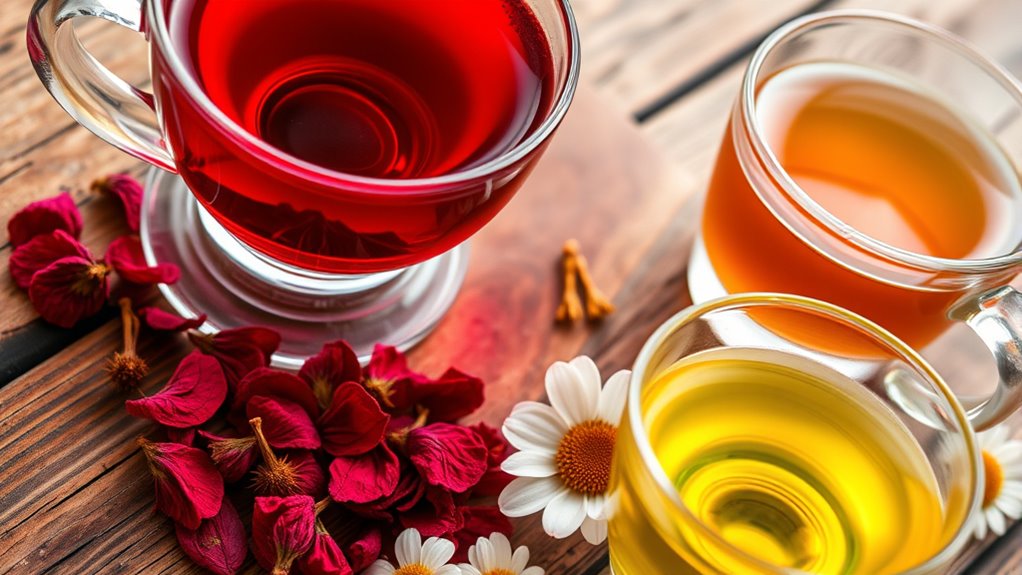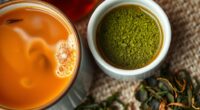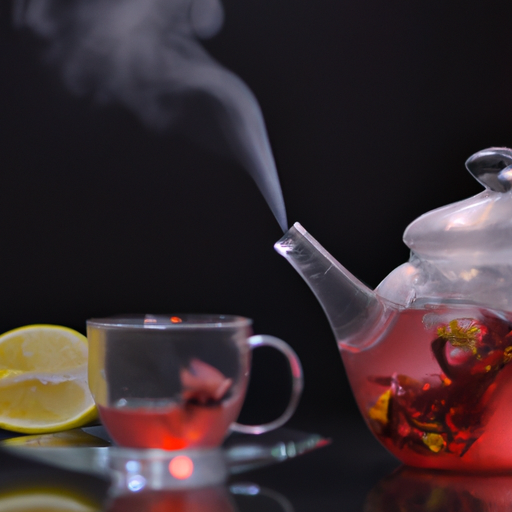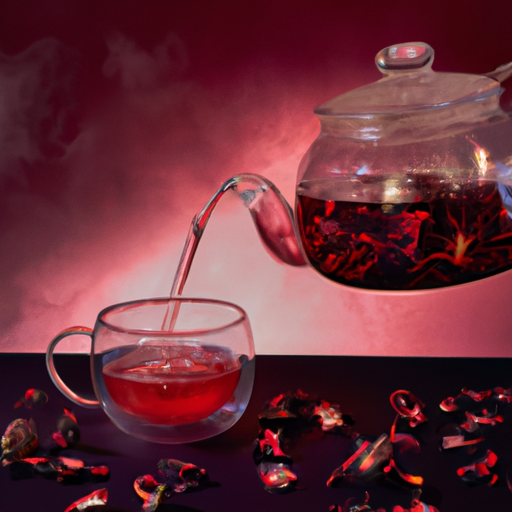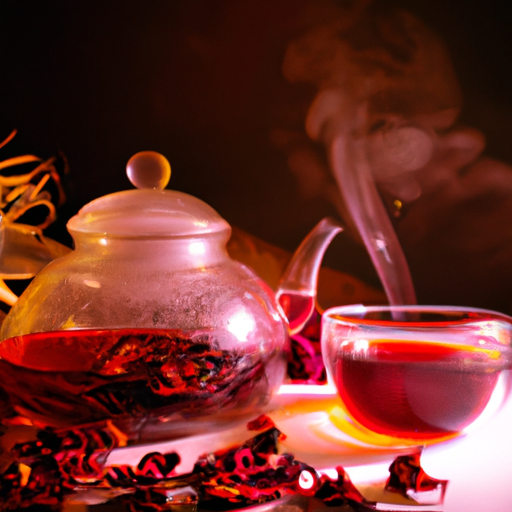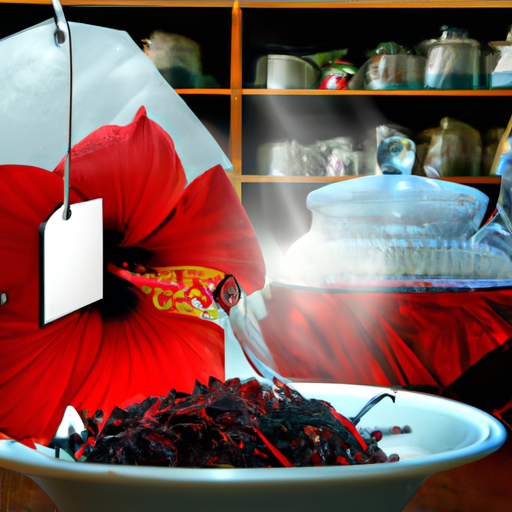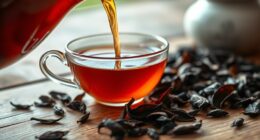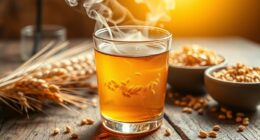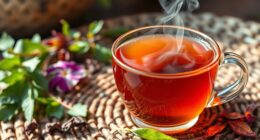Hibiscus tea offers a vibrant, crimson color and a tangy flavor that sets it apart from black or green teas, which tend to be more earthy or grassy. It’s caffeine-free and packed with antioxidants, making it a great choice for heart health and blood pressure support. Unlike other teas, hibiscus has a bright, invigorating taste perfect served hot or iced. Keep exploring to discover how its unique qualities compare even further to traditional teas.
Key Takeaways
- Hibiscus tea is caffeine-free with a vibrant crimson color, unlike caffeinated black and green teas.
- It offers a tangy, bright flavor with high antioxidant content, contrasting the earthy notes of black/green teas.
- Hibiscus supports cardiovascular health and blood pressure regulation, whereas other teas may focus on alertness or digestion.
- Its rich organic acids provide a tart taste, making it a refreshing alternative for those seeking a healthy, flavorful beverage.
- Hibiscus can be enjoyed hot or iced, providing versatility and visual appeal absent in many traditional teas.
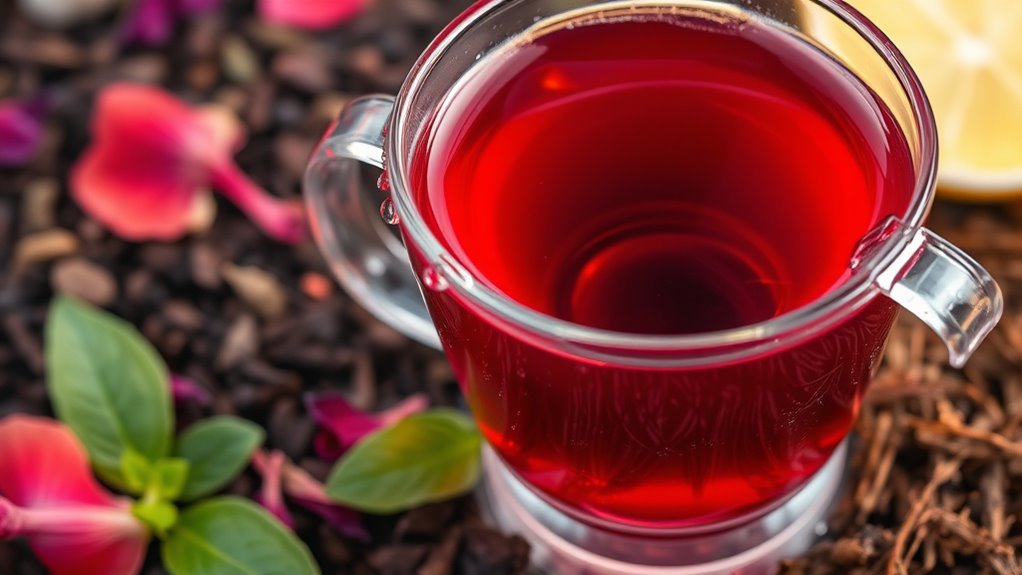
Hibiscus tea stands out among various herbal and traditional teas because of its vibrant color and unique tart flavor. When comparing hibiscus to other teas, one of the first things you notice is its potential health benefits. Many studies suggest that drinking hibiscus tea can help lower blood pressure, improve cholesterol levels, and support cardiovascular health. Its rich antioxidant content, including anthocyanins and flavonoids, helps combat free radicals, reducing oxidative stress in your body. Unlike black or green teas that contain caffeine, hibiscus tea is naturally caffeine-free, making it an excellent choice if you’re sensitive to caffeine or want a soothing beverage without the jitters. This absence of caffeine means you can enjoy it any time of day without disrupting your sleep or causing a caffeine crash later.
Hibiscus tea offers vibrant color, tart flavor, and caffeine-free health benefits for your well-being.
Additionally, the preparation of hibiscus tea often involves proper steeping techniques that maximize flavor and health benefits, ensuring you get the most out of each cup. When you compare hibiscus to black or green tea, you’ll also notice a difference in flavor profile. Black and green teas tend to have more earthy, grassy, or malty notes, while hibiscus delivers a bright, tangy taste reminiscent of cranberries or pomegranate. This tartness comes from organic acids like citric and malic acids, which give hibiscus its distinctive flavor and also provide additional health perks, such as aiding digestion. Because of its bold flavor, hibiscus can be enjoyed hot or iced, often sweetened with a bit of honey or mixed with fruits for an invigorating drink. Its vibrant crimson hue adds visual appeal, making it a popular choice for beverages that are both flavorful and eye-catching.
In terms of health benefits, hibiscus tea offers a different set of advantages compared to other herbal teas like chamomile or peppermint. While chamomile is known for its calming effects and peppermint for digestion, hibiscus is focused on cardiovascular health and blood pressure regulation. Its caffeine-free nature makes it a versatile option if you’re looking to reduce your caffeine intake while still enjoying a flavorful, health-boosting beverage. On the other hand, teas like black or green contain caffeine, which can give you a mental alertness boost but may also lead to jitters or crashes if consumed excessively.
Ultimately, when comparing hibiscus to other teas, you find that it provides a unique combination of health benefits, caffeine-free relaxation, and bold flavor. Whether you’re seeking to improve your heart health or simply enjoy a tangy, vitalizing drink, hibiscus tea stands out as an excellent alternative to traditional caffeinated teas. Its vibrant color and distinctive taste make it a standout choice that can complement a healthy lifestyle while satisfying your palate.
Frequently Asked Questions
Is Hibiscus Tea Suitable for All Ages?
Hibiscus tea is generally suitable for most ages, but you should consider age appropriateness and taste preferences. Young children might find its tart flavor too strong, so dilute it or offer smaller servings. For older adults, it can be a healthy choice due to its antioxidants. Always check for any allergies or health conditions, and consult a healthcare provider if unsure. Adjust serving sizes to suit individual taste and age needs.
How Does Hibiscus Tea Affect Blood Pressure?
Hibiscus tea acts like a gentle breeze on your blood vessels, helping to maintain blood pressure smoothly. Its natural properties support blood pressure regulation, making it a valuable addition to herbal medicine benefits. Drinking this vibrant, tangy brew can help lower high blood pressure levels, promoting heart health. Just remember, moderation is key, and consulting your healthcare provider ensures it complements your overall wellness plan.
Can Hibiscus Tea Replace Traditional Black or Green Teas?
Yes, hibiscus tea can replace traditional black or green teas, especially if you prefer a different flavor profile. Its tart, fruity taste offers a unique experience, while its caffeine content is lower, making it a good choice for a relaxing drink. However, if you rely on caffeine for energy, you might miss the boost from black or green teas. Try it to diversify your tea routine without sacrificing flavor or alertness.
Are There Any Allergies Linked to Hibiscus Tea?
Imagine a delicate bloom hiding potential surprises—you might experience allergy symptoms like itching or swelling after drinking hibiscus tea. While rare, some people do have allergies to hibiscus, and cross reactivity concerns with other plants in the Malvaceae family exist. If you notice any adverse reactions, it’s best to stop consuming it and consult a healthcare professional. Always listen to your body; it’s your best guide.
What Are the Best Ways to Brew Hibiscus Tea?
To brew hibiscus tea, start by steeping dried hibiscus petals in boiling water for about 5-10 minutes, depending on how strong you like it. Use brewing techniques like hot infusion for a vibrant flavor and aroma. For flavor infusions, add herbs or spices during steeping to enhance taste. Once brewed, strain out the petals, and enjoy your invigorating, tangy hibiscus tea hot or cold.
Conclusion
So, next time you choose between teas, consider hibiscus. Some believe it can lower blood pressure more effectively than black or green tea, but scientific proof remains mixed. While it’s rich in antioxidants and offers a vibrant flavor, don’t forget that each tea has unique benefits. Whether hibiscus truly outperforms others or not, trying different teas can boost your health and satisfy your taste buds. Why not explore hibiscus and see if it lives up to the hype?

